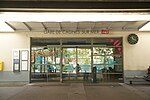Cagne
Alpes-Maritimes geography stubsCoastal basins of the Mediterranean Sea in FranceFrance river stubsRivers of Alpes-MaritimesRivers of France ... and 1 more
Rivers of Provence-Alpes-Côte d'Azur

The Cagne is a river that flows through the Alpes-Maritimes department of southeastern France. Its source is near Coursegoules, and it flows into the Mediterranean Sea in Cagnes-sur-Mer. It is 27.5 km (17.1 mi) long. The Malvan is one of its tributaries.
Excerpt from the Wikipedia article Cagne (License: CC BY-SA 3.0, Authors, Images).Cagne
Promenade de la Plage, Grasse
Geographical coordinates (GPS) Address Nearby Places Show on map
Geographical coordinates (GPS)
| Latitude | Longitude |
|---|---|
| N 43.6526 ° | E 7.1554 ° |
Address
Cagnes Ski Nautique Club
Promenade de la Plage
06800 Grasse
Provence-Alpes-Côte d'Azur, France
Open on Google Maps







